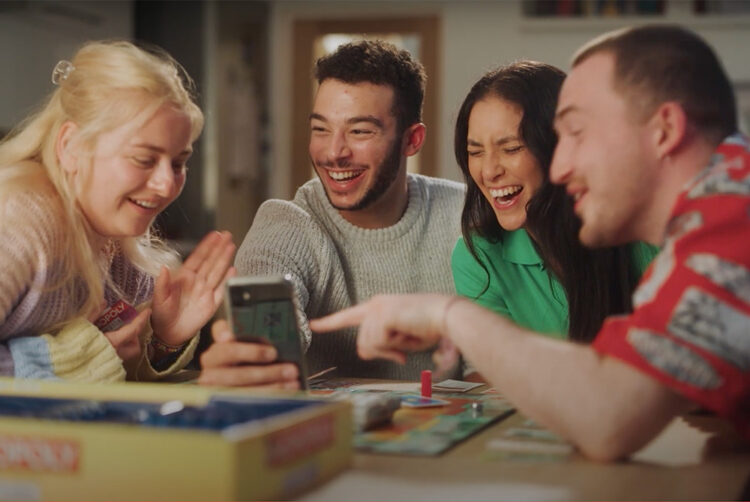Ad tech company Say It Now plans to introduce actionable smart-speaker ads for TV later this month, and out-of-home next year.
This is in addition to its actionable audio ads and form part of founder and CEO Charlie Cadbury’s “overarching mission to make it possible to engage with every advertising message using your voice”.
These actionable ads, based on using voice commands with smart speakers, have been used by brands such as Tesco, Specsavers, Pizza Hut and Berocca within the last year and are typically used to for response advertising around products with high awareness, such as reducing the friction of booking appointments or purchasing products.
 Cadbury (pictured, left) told The Media Leader that the company had taken out trademarks on actionable audio, TV and outdoor ads in 2019 when the company was set up.
Cadbury (pictured, left) told The Media Leader that the company had taken out trademarks on actionable audio, TV and outdoor ads in 2019 when the company was set up.
Actionable ads, he says, respond to evolving behaviour in households and “solve all of those problems or challenges” around engagement, attribution and measurement of ads on these media channels.
“We can show when people are engaging. No one is going to say “Alexa, open pizza delivery” unless they’ve seen the ad, and we know the benchmarks of how many ads you need to run in order to get a certain kind of voice-through rate or response rate. So we can say with some level of confidence how many of these ads have actually been shown. It’s another way to verify that those ads are running.”
The actionable ads, whether they run on audio, TV or OOH, operate with “exactly the same” two sides to their tech stack. One is a visual “builder” tool which creates a branded voice experience. This will be opened up to partners to use themselves later this year.
The second side is a live dashboard showing where the ad has been served, which conversational routes consumers are coming through and a campaign optimiser option. Cadbury added that this real-time data changes the way agencies can plan and buy in audio, for example, as the feedback loop for an audio campaign historically was around a quarter or two to three months.
Cadbury explained: “What we can now do is we can start to have an early-bird campaign report on the first day it starts to run, but usually after the first week we can say: look, these are the creatives which are running which are being engaged with the most, this is the time of day or even the location that people are engaging with the most, so maybe let’s up-weight our media spend there and down-weight in areas which aren’t performing so well. Thus, every advertising pound then goes further.”
In terms of creative, he also said Say It Now “haven’t done anything clever on the creative”.
Cadbury said: “The only difference is that if you hear one of our ads, it’d be: “Today’s pizza night, if you’d like to get 50% off your pizza tonight, just say Alexa, open pizza delivery”. You then have this back and forth conversation with Alexa, and she says: “can I send you a coupon to get your pizza?”, then you say “yes”. And then you continue listening to the radio.”
TV focus using audio playbook
Cadbury said he is “focussed on TV for this year”, using the “playbook” the company developed last year with actionable audio.
Say It Now has finished “a six-month exclusive partnership” on connected TV in January, and is set to launch its first big connected TV campaign across the whole of the US this month for “a big state trying to entice you to go to this state”,
He said: “We’ve got this base level of understanding of voice can be a landing point. It’s quite a natural leap to say we understand that the audio was just a driver to the voice landing point, and it makes sense that TV is just another driver to that landing point.”
When actionable ads launch on connected TV, there will be options to target by postcode, for example, so the argument is brands can target areas they are active in, for instance delivery areas for quick-service delivery advertisers, and thereby minimise media wastage.
On actionable outdoor ads, Cadbury said: “The behaviour is not there quite yet, but within the next year or two when you buy your next car, it will have a voice assistant baked in.”
He cited research from Arianne Walker, “chief evangelist” for Alexa Auto at Amazon, that showed when a consumer chooses a voice assistant at home, they will then take that with them in the car, especially as cars are increasingly connected to the internet and, it is argued, becoming like mobile phones.
“So when we’re turning on the outdoor piece, which which will be in the next year most likely, when you’re driving into London past Global’s big outdoor signs on the M4 and one of them says: ‘Hey, come to Mauritius to find out more and to book your holiday there then just ask your system to open to Mauritius’ and as you drive it along, you will say “Hey Alexa, open to Mauritius” and you’ll have a conversation about booking your holiday and by the time you get home there’s a booking confirmation and itinerary in your inbox.”
“That then turns on the lights and delivers attribution because we get that location data attribution for outdoor which is the last big bastion of digital attribution as a whole rising tide of digital out of home.”
Adwanted UK is the trusted delivery partner for three essential services which deliver accountability, standardisation, and audience data for the out-of-home industry.
Playout is Outsmart’s new system to centralise and standardise playout reporting data across all outdoor media owners in the UK.
SPACE is the industry’s comprehensive inventory database delivered through a collaboration between IPAO and Outsmart.
The RouteAPI is a SaaS solution which delivers the ooh industry’s audience data quickly and simply into clients’ systems.
Contact us for more information on SPACE, J-ET, Audiotrack or our data engines.






 Cadbury (pictured, left) told The Media Leader that the company had taken out trademarks on actionable audio, TV and outdoor ads in 2019 when the company was set up.
Cadbury (pictured, left) told The Media Leader that the company had taken out trademarks on actionable audio, TV and outdoor ads in 2019 when the company was set up.